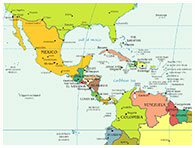J'ai eu la chance de passer 15 jours au Panama, du 25 août au 8 septembre 2012 pour y observer les libellules en compagnie d'un groupe anglo-américain et danois, accompagné de Dennis Paulson, expert odonatologue de renommée mondiale, qui connaît particulièrement bien cette région.
Le climat est chaud, très humide; c'est la saison des pluies qui surviennent principalement sous forme d'orage, l'après-midi s'accompagnant parfois de quantités d'eau effarantes.
Les milieux sont variés; la région du canal, sensiblement au niveau de la mer, en forêt pluviale ou nous prospectons les allées souvent ombragées, les ruisseaux, lacs ou rivières qui alimentent le canal.
Puis plus loin de Panama, en basse montagne, avec un paysage forestier et des ruisseaux, torrents, petites rivières, mares ou rizières. Avec parfois de petits torrents très ombragés ou les surprises sont au rendez-vous.
Même si le nombre d'espèces observées n'est pas encore exactement défini, je pense qu'il se situe autour de 110. Pour mon compte 86 odonates en photos et 108 pour le groupe entier.
Certaines sont sans doute totalement nouvelles, d'autres non décrites encore, une vient tout juste d'être officiellement baptisée.
Merci à Dennis Paulson pour sa disponibilité et l'aide qu'il m'a patiemment apportée pour de nombreuses déterminations.
Les photos des espèces en "grisé" ont été prises par des compagnons de voyage et m'ont été confiées pour réunir toutes les espèces vues sur un seul site.
Le climat est chaud, très humide; c'est la saison des pluies qui surviennent principalement sous forme d'orage, l'après-midi s'accompagnant parfois de quantités d'eau effarantes.
Les milieux sont variés; la région du canal, sensiblement au niveau de la mer, en forêt pluviale ou nous prospectons les allées souvent ombragées, les ruisseaux, lacs ou rivières qui alimentent le canal.
Puis plus loin de Panama, en basse montagne, avec un paysage forestier et des ruisseaux, torrents, petites rivières, mares ou rizières. Avec parfois de petits torrents très ombragés ou les surprises sont au rendez-vous.
Même si le nombre d'espèces observées n'est pas encore exactement défini, je pense qu'il se situe autour de 110. Pour mon compte 86 odonates en photos et 108 pour le groupe entier.
Certaines sont sans doute totalement nouvelles, d'autres non décrites encore, une vient tout juste d'être officiellement baptisée.
Merci à Dennis Paulson pour sa disponibilité et l'aide qu'il m'a patiemment apportée pour de nombreuses déterminations.
Les photos des espèces en "grisé" ont été prises par des compagnons de voyage et m'ont été confiées pour réunir toutes les espèces vues sur un seul site.
English translation (Thanks to Dave Smallshire).
I had the chance to spend 15 days in Panama, from 25 August to 8 September 2012, to observe dragonflies with a group from England, America and Denmark, accompanied by Dennis Paulson, expert on the dragonflies of the Americas.
The climate was hot and very humid; it was the rainy season, which occurs mainly in the form of a storm in the afternoon sometimes with staggering amounts of water.
The habitats were varied: the canal region, approximately at sea level, or in rainforest, we explored the often shaded streams, lakes or rivers that feed the canal. Then later, further west in Panama, we explored low mountains with a forested landscape and streams, small rivers, ponds or rice paddies. Sometimes, surprises await you along very small shaded streams. Although the number of species observed is not yet confirmed, I think it is around 110, of which I photographed 86 and the entire group 108. Some are probably completely new to science, others not yet described and officially named.
I had the chance to spend 15 days in Panama, from 25 August to 8 September 2012, to observe dragonflies with a group from England, America and Denmark, accompanied by Dennis Paulson, expert on the dragonflies of the Americas.
The climate was hot and very humid; it was the rainy season, which occurs mainly in the form of a storm in the afternoon sometimes with staggering amounts of water.
The habitats were varied: the canal region, approximately at sea level, or in rainforest, we explored the often shaded streams, lakes or rivers that feed the canal. Then later, further west in Panama, we explored low mountains with a forested landscape and streams, small rivers, ponds or rice paddies. Sometimes, surprises await you along very small shaded streams. Although the number of species observed is not yet confirmed, I think it is around 110, of which I photographed 86 and the entire group 108. Some are probably completely new to science, others not yet described and officially named.
Libellules du Panama 
Clic...
